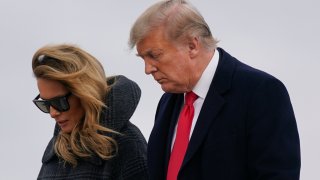
President Donald Trump delivered a year-end video message Thursday after returning early from vacation, highlighting his administration’s work to rapidly develop a vaccine against COVID-19 and rebuild the economy.
As the end of his presidency neared, Trump cut short his stay at his Mar-a-Lago club in Florida and got back to the White House a day ahead of schedule.
Upon his return, Trump released a video message over Twitter to underscore his administration’s work on the vaccine, economic stimulus checks and America’s “grit, strength and tenacity” in the face of challenges.
He called the vaccine, which is rolling out nationwide, a “truly unprecedented medical miracle” and said it would be available to every American early this coming year. “We have to be remembered for what’s been done,” Trump said in the nearly five-minute message.
The White House didn't give a reason for Trump's early return, and the schedule change means Trump will miss the glitzy New Year’s Eve party held annually at his Palm Beach club.
But it comes as tensions escalate between the United States and Iran in the final weeks of his administration. There is concern in Washington that Iran could order further military retaliation for the U.S. killing last Jan. 3 of top Iranian military commander Gen. Qasem Soleimani. Iran’s initial response, five days after that deadly U.S. drone strike, was a ballistic missile attack on a military base in Iraq that caused brain concussion injuries to about 100 U.S. troops.
Iranian-supported Shiite militia groups launched a rocket attack on the U.S. Embassy compound in Baghdad on Dec. 20. No one was killed, but Trump said days later that Iran was on notice.
U.S. & World
“Some friendly health advice to Iran: If one American is killed, I will hold Iran responsible. Think it over,” Trump tweeted on Dec. 23. He added, ”We hear chatter of additional attacks against Americans in Iraq.”
The White House announced the abrupt change in the president’s schedule late Wednesday, hours after Sen. Josh Hawley, R-Mo., said he would raise objections next week when Congress meets to affirm President-elect Joe Biden’s victory in the November election.
It's the latest futile attempt by Trump and his allies to fight his election defeat and overturn the will of the voters, and scores of previous challenges have failed, including at the Supreme Court. Former Attorney General William Barr and other administration officials have said they saw no evidence of mass voter fraud, as Trump has claimed.
Trump, accompanied by first lady Melania Trump, arrived at Mar-a-Lago after dark on Dec. 23 and spent practically the entire vacation focused on subverting the election results. That includes an effort to get Republican lawmakers to challenge the vote when Congress meets Jan. 6 to affirm Biden’s 306-232 win in the Electoral College.
A group of Republicans in the Democratic-controlled House already had said they will object on Trump’s behalf. They needed at least one senator to join them to force votes in both chambers, and Hawley stepped up.
The GOP objections, however, will not prevent Biden from being sworn in as president on Jan. 20, and Sen. Kamala Harris, D-Calif., a Black woman of South Asian descent, from becoming vice president.
During his vacation, Trump also took near daily swipes on Twitter at Georgia Republican Gov. Brian Kemp and other state elections officials over his loss to Biden in that state.
While he has remained focused on the effort to stay in power, Trump has stayed mum on major developments during the holiday break, including a Christmas Day bombing in Nashville, Tennessee, the discovery of a new and apparently more contagious variant of the coronavirus in the United States and the death of Rep.-elect Luke Letlow, R-La., from COVID-19 complications.
Since losing the election, the usually chatty Trump has avoided engaging with reporters, even those who accompanied him to Florida. He went as far as barring them from his Christmas Day remarks to the troops, the type of event the White House typically opens for news coverage.
Before he left Washington, Trump stunned Capitol Hill by objecting to spending in a government funding bill that had been paired with a fresh round of needed coronavirus relief that included $600 payments to most Americans. Much of that spending had been sought by his own administration.
Trump jeopardized the financial aid and flirted with a government shutdown by implying that he wouldn’t sign the sweeping legislation unless lawmakers increased the payments to $2,000, a sum sought by most Democrats and some Republicans.
Trump eventually signed the bill Sunday night after several days of uncertainty in exchange for congressional votes on his demands. He also wants Congress to lift certain protections for social media companies and investigate his unfounded claims of fraud in the election.
The House voted this week in favor of increasing the payments, but Senate Majority Leader Mitch McConnell, R-Ky., all but shut the door Wednesday when he declared that Congress had provided enough pandemic aid. McConnell blocked attempts by Democrats to force a vote in that chamber on the higher payments sought by Trump.



